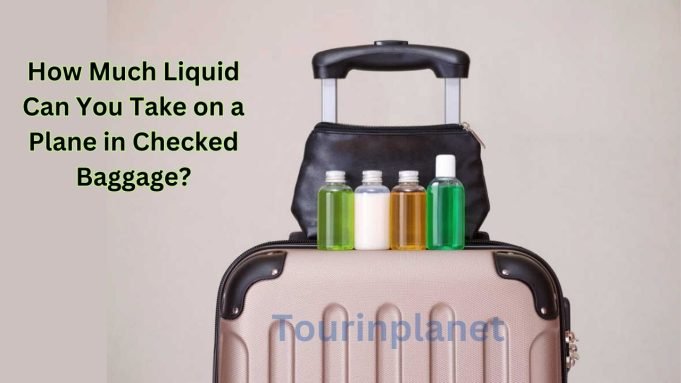Traveling by air can be an exciting and convenient way to reach our destinations, but it comes with its fair share of rules and regulations. One area where travelers often find themselves puzzled is understanding how much liquid they can carry in their checked baggage.
Are you preparing for an exciting adventure, but unsure about the rules surrounding liquid items in your checked baggage? Do you find yourself wondering just how much liquid you can safely carry onto a plane? Fear not, for we have the answers you seek! In this comprehensive article, we will demystify the Transportation Security Administration’s (TSA) liquid restrictions for checked baggage, guiding you through container size limitations, total volume allowances, and special considerations for essential items like medications and baby supplies. Join us as we unravel the dos and don’ts of packing liquids for your air travel journey!
TSA Liquids Rule
The TSA’s liquid rule was implemented in 2006 as a response to a thwarted terrorist plot. It limits the number of liquids that passengers can carry onto airplanes to prevent the potential use of liquid explosives. In checked baggage, the TSA allows larger quantities of liquids compared to carry-on luggage, but there are still restrictions.
Passengers are permitted to transport liquids in their checked bags, provided they adhere to the following guidelines:
Liquid Container Size Restrictions
Total Liquid Volume Allowed in Checked Baggage
Exceptions and Special Considerations
Definition of Liquids
Examples of Common Liquids Travelers May Carry
Items That May Be Excluded from the Liquids Rule
How Much Liquid Can You Take on a Plane in Checked Baggage?
Transporting Alcoholic Beverages:
Alcoholic beverages in checked baggage must adhere to specific alcohol-by-volume (ABV) limits. Liquids with over 70% ABV (140 proof) are prohibited due to their high flammability. However, those between 24% and 70% ABV can be transported in quantities under five liters. Alcoholic beverages below 24% ABV have no restrictions, but always check the import regulations of your destination country.
Rubbing Alcohol Limits:
Isopropyl alcohol, commonly known as rubbing alcohol, is also subject to restrictions. Each container of rubbing alcohol should not exceed 18 ounces. Be sure to check with your airline for any specific policies. As rubbing alcohol is widely available, it might be more convenient to purchase it at your destination.
Aerosol Products:
Toiletry and medicinal aerosols in checked baggage must be stored in containers with a capacity of fewer than 500 ml (18 ounces). Each person is allowed to bring up to 70 ounces (two liters) of aerosol in total. This applies to sprays, deodorants, and other aerosol toiletries.
Flammable and Hazardous Items:
Items such as chlorine liquid, flammable paints, liquid fuel, gasoline, lighter fluid, and bleach, and their derivatives are strictly prohibited in checked baggage, regardless of quantity.
Cleaning Supplies:
Cleaning supplies are generally permitted in checked baggage, provided they are non-flammable. To be sure, check product descriptions for flammability indications. Leaving them in their original containers helps identification during screening. There are no liquid limits for cleaning products.
Self-Defense Sprays:
Each passenger is allowed to carry only one self-defense spray, limited to four ounces (120 ml) of liquid. Tear gas sprays must contain no more than 2% CN or CS to prevent accidental discharge. Similar rules apply to pepper sprays and other self-defense sprays.
Packaging and Containers
Accepted Container Types and Materials
How to Prevent Leaks and Spills
Special Liquid Items
Medications and Medical Supplies
Travelers carrying prescription medications and medical supplies must follow specific guidelines to ensure smooth security screening. It is advisable to keep medications in their original containers, accompanied by relevant prescriptions.
Necessary Documentation and Prescriptions: Carry a copy of your prescription and a letter from your doctor explaining the need for the medication.
Quantities Allowed: In most cases, there are no strict quantity restrictions for medications in checked baggage. However, it’s best to carry only the amount needed for the duration of your trip.
Baby Formula, Breast Milk, and Baby Food
Parents traveling with infants are allowed to bring certain amounts of baby formula, breast milk, and baby food, even if they exceed the standard liquid limitations.
Limitations and Allowances: While there is no hard limit on the quantity of baby formula or breast milk, it is subject to additional screening. Baby food in jars or pouches is also permitted, but it must be presented for separate screening.
Screening Procedures: Be prepared for additional screening at security checkpoints when carrying these items.
Duty-Free Liquids
Passengers purchasing duty-free liquids at airport shops are permitted to carry them in their checked baggage. However, they must be placed in a secure, tamper-evident bag with the receipt visible for inspection.
Rules for Purchasing Liquids at the Airport: Duty-free liquids can only be purchased at shops after the security checkpoint.
Transporting Duty-Free Items in Checked Luggage: Once purchased, keep the duty-free liquids in their sealed bags until you reach your final destination. Do not open the bag or consume any of the contents during your journey.
Liquids on International Flights
When traveling internationally, it is essential to consider the liquid restrictions of both your departure and arrival countries. Some countries may have stricter rules regarding liquids, and passengers are required to comply with the most stringent regulations.
Comparing Liquid Regulations in Different Countries: Research the liquid limitations of both your departure and destination countries to avoid any issues during international travel.
Complying with the Strictest Rules When Traveling Internationally: To ensure smooth transitions during international travel, adhere to the liquid restrictions imposed by the most restrictive country.
Resources for Checking Liquid Restrictions in Specific Countries: Government websites, airlines, and travel forums can provide up-to-date information on liquid restrictions for specific countries.
Tips for Travelers
Travelers can adopt various strategies to stay within the liquid limitations and make their journey more convenient.
Packing Strategies to Stay Within the Limits: Minimize the liquids you carry by using travel-sized products or purchasing items at your destination.
Utilizing Travel-Sized Products and Samples: Many toiletries and personal care items are available in travel-sized versions or as samples, which are TSA-approved and can help you stay within the restrictions.
Considerations for Long-Haul or Extended Travel: If you’re embarking on a long-haul trip, plan ahead for any essential liquid items you might need during the journey.
Consequences of Non-Compliance
Failure to comply with TSA’s liquid restrictions can lead to inconveniences and delays during the screening process.
Potential Repercussions for Exceeding Liquid Limitations: If your checked baggage contains liquids exceeding the allowed limit, the TSA may discard the excess items, or you may be asked to transfer them to your carry-on bag or dispose of them.
TSA Screening Procedures for Liquids in Checked Baggage: Expect your checked luggage to undergo additional screening if it contains liquids. This may result in longer waiting times and potential delays.
Instances of Confiscated Items and Their Disposal: Any liquids confiscated during security screenings are typically disposed of to maintain passenger safety.
















[…] ALSO READ: How Much Liquid Can You Take on a Plane in Checked Baggage? […]
[…] deodorants are permitted in carry-on luggage, what the size limits are, and how rules differ for checked baggage. This guide will help you pack confidently and avoid unexpected delays or confiscations at the […]
[…] are generally not permitted in checked baggage unless they are empty or secured in a DOT-approved case. Torch lighters, commonly used for cigars, […]
[…] not included: Neither carry-ons nor checked baggage are part of the pass. Expect to pay $40–$70+ per […]
Comments are closed.